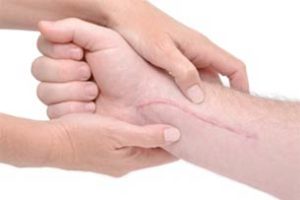
A laceration is a rip, cut, or tear in the skin and can be a minor or serious injury. Laceration injuries can occur in many types of accidents and to any accident victim. Often, victims of car accidents sustain lacerations when a windshield or window breaks or shatters, sending broken glass flying. This broken glass is usually very sharp and easily cuts skin, leaving a laceration that may be minor or severe.
Another common source of lacerations is defective products. When using or holding a product that was defectively designed or manufactured, a defect in the product may result in a dangerously sharp or jagged section that can lead to cuts. Other products may fail or break apart, causing cuts or tears in a victim’s skin as it happens. Many products contain glass components that can shatter much like a windshield and can injure those using the product or those who are standing in the immediate area when the product breaks.
Though the skin is designed to repair itself and close over open wounds, the results of the healing process are not perfect and often result in a scar. The degree to which you scar and the resulting appearance of a scar depends greatly on the type of injury sustained, the location of the injury, your age, your sex, and your ethnicity.
Lacerations often result in serious and disfiguring scars. Some scars may be small and not noticeable but for many accident victims, the scars are large, discolored, or raised and are in a place that cannot be easily hidden, like on a face, neck, hands, or arms. When this happens, a victim’s injuries are not only the cuts received in an accident, but also the resulting scars, which will last a lifetime.
Another source of scars after an accident is through surgery. Regardless of what type of injury was sustained, if a victim is forced to undergo surgery, there will almost always be a scar. Scars are not only visually unattractive but they can produce physical challenges as well. Scars may be more sensitive than surrounding tissues to heat or to cold. Often, victims must take extra caution while out in the sun because scars are likely to sunburn much more quickly and easily than healthy skin. Some scars are so severe that they require revision surgery to reduce them, though this never fully eliminates a scar.
Doctors recognize several types of scars based on their characteristics, including:
- Keloid Scars – Keloid scars occur when the body’s healing process is over-aggressive or tries to do too much. A keloid scar can be identified by the fact that it extends beyond the bounds of the original cut or injury. Keloids often are associated with scar tissue which causes the scar to be raised and stiff. If located in the area of a joint, a keloid scar can have very negative effects on the joint’s mobility, which can worsen over time.
- Hypertrophic Scars – Hypertropic scars are similar in appearance to keloid scars. They are often raised from the surface of the skin and slightly red in color but unlike keloid scars, hypertrophic scars do not extent beyond the bounds of the original injury.
- Contracture Scars – Deep injuries caused by burns or sometimes gouging can result in contracture scars. These scars are distinguishable by their tight appearance and often look like the surrounding skin has been pulled too tightly over an injury. Many of these scars have wrinkles or lines running from the outside edges of the scar towards the middle. Severe burns result in contracture scars, which like keloid scars, can develop scar tissue and significantly decrease mobility.
Unfortunately, there is no way to prevent scars from forming. Some treatments exist to limit the appearance of scars once they have formed and they provide some relief, but the scar will always exist to a degree. Treatments may include scar revision surgery, over-the-counter topical ointments to reduce the scarring, and steroid injections to reduce the raised appearance of some scars. A doctor who practices in scar treatment can help you understand what medical options may be available to you.
Scars have a large economic impact on victims as well as being unsightly. Visible scars, especially those located on the face or neck, may make a victim less employable in some fields. Some employers are hesitant or unwilling to hire visually scarred workers because of what clients might think, what co-workers might do or say, or even out of bias. Though these actions may not be legal, they still may occur, further victimizing an accident victim and causing the injuries to continue through a lifetime.
Lawyers at Abels & Annes, P.C. often represent clients who have suffered injuries that result in permanent scarring. Laceration injuries can cause pain and discomfort, and eventual permanent disfigurement. Often our clients consult and treat with plastic surgeons in the Chicago area.
Scars can result from Chicago auto accidents, slip & falls, work accidents, and many other types of injury cases. Scars also result when clients undergo surgery to repair serious fractures or broken bones.
We will help you recover for your medical expenses, pain and suffering, disfigurement, loss of normal life, loss of income, and any other damages incurred in an accident. We look to recover present and future costs when representing an injured victim.
If you or a family member have suffered a laceration/scar injury, request a Free Case Consultation or call (312) 924-7575 to speak with a lawyer now.